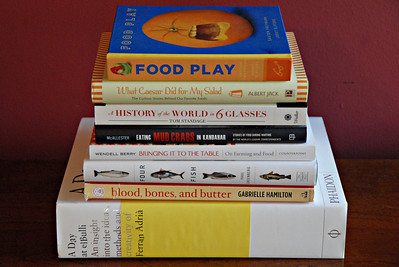
I confess — I’ve struggled with a lifelong addiction to books. You need only look at my overflowing bookshelves, desk, nightstand, coffee table . . . really any flat surface in my house and you will see the ridiculous number of books on which I’ve become hooked.
Culinary narratives are invariably part of my stash. Call it an occupational hazard or personal weakness but I just can’t escape the lure of food writing.
Below are the high points of my 2011 culinary reading list. Some are recent releases. A few are a bit older. All would make great gifts for the food lovers and ardent home cooks in your life. Look for these titles at your local independent bookstores or online from such independent sellers as Kitchen Arts and Letters, Powell’s and The Strand.
A Day at El Bulli by Ferran Adria (Phaidon Press, 2008)
Although Chef Ferran Adria has shuttered his world-renowned restaurant, you can still get a glimpse inside his temple to molecular gastronomy, El Bulli. A Day at El Bulli provides 600 beautifully illustrated pages covering a day in the life of the restaurant. By the time that you’ve reached the final page, you’ll feel as though you’ve not only dined many times but also worked behind the stove at this seminal restaurant.
Bringing It to the Table by Wendell Berry (Counterpoint, 2009)
Long before Michael Pollan got folks to question how and what they ate, there was Wendell Berry. Longtime writer, scholar and farmer, Berry has extolled the virtues of sustainable agriculture and eating for over five decades. This collection presents some of Berry’s best non-fiction writings on these topics. It’s essential reading for anyone concerned about mindful eating and living.
Food Play by Saxton Freyman and Joost Elffers (Chronicle Books, 2006)
My guilty pleasure and culinary photography recommendation for the past five years, Food Play provides the most fun that anyone will ever have looking at food. Featuring whimsical tableaus of fruits and veggies, this colorful book will delight readers of any age. I mean, really, who wouldn’t adore looking at strawberry dogs or a flock of cauliflower sheep?
Four Fish by Paul Greenberg (Penguin, 2011)
Anyone who eats fish should receive a copy of Paul Greenberg’s book. Intelligent, witty and always fascinating, Four Fish explores man’s long, troubled relationship with cod, salmon, sea bass and tuna, the four fish that dominate our menus. Greenberg, who is a lifelong fisherman as well as a seasoned writer, provides a balanced yet page turning account of the crises facing fish today.
Blood, Bones & Butter by Gabrielle Hamilton (Random House, 2011)
Whether you’re a fan of her writings in the New York Times or of her Lower East Side restaurant Prune or just looking for a good culinary memoir, check out Gabrielle Hamilton’s long-awaited first book. Entertaining and sharp, Hamilton shares her unique, often rocky path to becoming a chef. As with any good chef or writer, her memoir will leave you hungering for more.
What Caesar Did for My Salad by Albert Jack (Perigee Trade, 2011)
Ever wonder how pasta or picnics came to be? What gave rise to and constitutes a full English breakfast? Why we call small, cooked sausages hot dogs? If so, Albert Jack’s fascinating tome is the book for you. What Caesar Did for My Salad looks at the origins of and fabled tales about some of our favorite foods. It’s a fun book for trivia lovers as well as diehard foodies.
Eating Mud Crabs in Kandahar Edited by Matt McAllester (University of California Press, 2011)
Even if your gift recipients didn’t have that childhood dream of becoming a war correspondent as I did, they will enjoy McAllester’s compilation of food tales from reporters in conflict zones. His riveting book looks at what it means to eat and what folks resort to eating in times of extreme hardship and violence. Intimate and engaging, these stories will stick with readers for months to come.
A History of the World in 6 Glasses by Tom Standage (Walker Publishing, 2006)
If you have history buffs on your shopping list, consider giving them A History of the World in 6 Glasses. Here British journalist Tom Standage explores six drinks — wine, beer, spirits, coffee, tea and soda — that shaped world history. Once your friends and loved ones have read Standage’s compelling book, they’ll never look at, or drink, a can of Coke the same way.